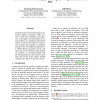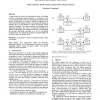322 search results - page 20 / 65 » Learning consumer preferences using semantic similarity |
NAACL
2007
13 years 11 months ago
2007
Collecting supervised training data for automatic speech recognition (ASR) systems is both time consuming and expensive. In this paper we use the notion of virtual evidence in a g...
ESWS
2008
Springer
13 years 11 months ago
2008
Springer
Abstract. Recommender systems face up to current information overload by selecting automatically items that match the personal preferences of each user. The so-called content-based...
JCAL
2010
13 years 4 months ago
2010
Personalized instruction is seen as a desideratum of today's e-learning systems. The focus of this paper is on those platforms that use learning styles as personalization crit...
SMI
2008
IEEE
14 years 4 months ago
2008
IEEE
A shape feature by itself is not sufficient for effective 3D model retrieval. Long-lasting semantics shared by a community as well as a short-lived intention of a user determines ...
CORR
2004
Springer
13 years 9 months ago
2004
Springer
Words and phrases acquire meaning from the way they are used in society, from their relative semantics to other words and phrases. For computers the equivalent of `society' is...


